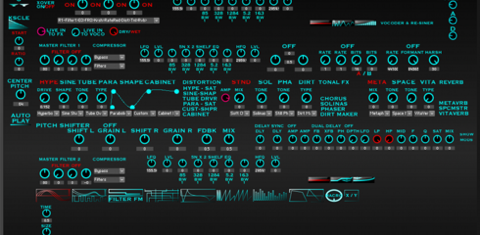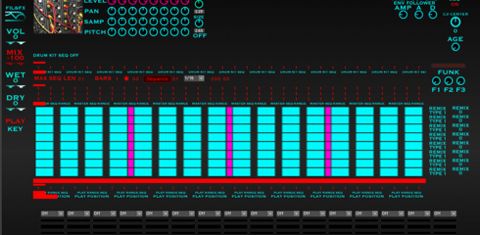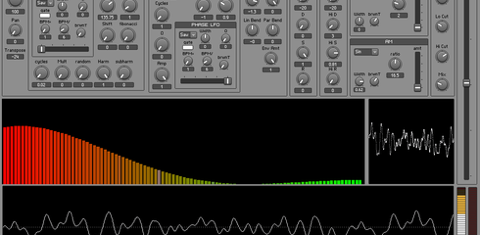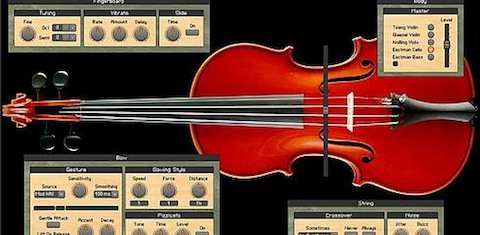Best of Reaktor User Library november 2.013
Effects
Hyroglyphicus FX
by Michael O'hagan
This is a multi FX Rack with a little bit of everything.
see here...
www.youtube.com/michaelohaganmusic
A multi FX rack with multiple modulation options.
***
Samplers
Hyroglyphicus Drum Synth
by Michael O'Hagan
An 8 part drum sampler and synthesizer with built in 8 channel sequencer
Watch the overview videos here...
www.youtube.com/michaelohaganmusic
This is an 8 part drum synthesizer and sampler with samples from 27 classic drum machines and an 8 part drum synthesis system.
the sequencer has a funk shuffler and remix options as well as an extended FX rack with tons of modulation options.
special thanks to http://boscomac.free.fr/?p=retrobeat
***
Synthesizers
Modeller
by Santiago Vilanova
PARTIAL MODELLING
My first experiment into additive synthesis.
Messing around with ratio and amplitude control through LFOs and functions.
Highly unefficient, but capable of nice evolving harmonic landscapes, modulated bass sounds and spectral madness
***
Serenade 3.0
by Chet Singer
Gesture-controlled violin, viola, cello, and contrabass synthesizer
EDIT: Version 3 has the following changes:
* The physical model is now 3x oversampled so high violin and viola notes are more clear.
* The noise circuit has been improved.
* String Sustain and Efficiency knobs have been added.
* Some new snaps have been added.
* The Hutchins viola has been replaced by a Glaesel viola.
Serenade is a synthesizer that mimics bowed string instruments. It is a physical model that includes a bow, a wooden body, and up to four strings. The wooden body is modeled using Colin Brown's zero-latency convolution core cell (thanks Colin!).
Six instruments are included: two violins, two violas, a cello, and a contrabass.
The model requires three variables: bow speed, bow force, and bow position. Bow speed is the speed that the bow is drawn across a string. Bow force is the pressure the bow places on a string as it is drawn. Bow position is the distance along the string from the bridge to the bowing point.
Like a violin, Serenade is controlled by gesture. As a violin is played by moving a bow back and forth while pressing it onto a string, Serenade is played by moving the modulation wheel or bow panel fader back and forth while pressing a key. Pressing a key supplies the bow force and moving the modulation wheel or bow panel fader supplies the bow speed.
To play Serenade, begin by holding down a key. Serenade will make no sound. That’s because you’re pressing the bow onto the string but you’re not moving it. While holding the key down, begin moving the bow panel fader or modulation wheel slowly back and forth. You’ll hear Serenade bowing the string. It's pretty sensitive, and not a lot of movement is required.
Features include:
• The bow’s force, speed, and distance from the bridge can be adjusted.
• A colored meter indicates the bow speed. Yellow indicates sufficient speed.
• Accents can be added to the beginnings of notes.
• Playing an interval several semitones or larger shifts the bow to another string.
• The sensitivity to gesture can be adjusted.
• The strings can be plucked instead of bowed.
• The bow can be automatically lifted from the strings at the end of a note.
• The finger can slide from one note to another along the fingerboard.
Caveats:
• Serenade is designed to be played via gesture, not sequenced.
• For best results the sample rate must be 44.1 kHz.
Serenade can be difficult to play. But then, so is a violin. Here are some hints to get the most out of it:
• The bow is sensitive. Reaching the yellow zone in the colored meter is sufficient to produce a good tone.
• Moving the bow suddenly can accentuate a note, controllable by the Accent and Decay knobs.
• Moving the bow force knob will make the tone rougher or smoother.
• Speeding and slowing the bow will create crescendos and decrescendos.
• Lifting a key while moving the bow will make the string ring briefly.
• Holding a key down while bringing the bow to a stop will make the note creak to a stop.
• Briefly pressing notes while moving the bow bounces it on the string.
• The Lift button lifts the bow from the string when the gesture suddenly stops, even if a key remains pressed.
The six body impulses are included along with the ensemble. They’re for reference only; the ensemble itself does all convolution required.
Serenade is based on bowed string models created by Drs. Chris Chafe, Perry Cook, Matthias Demoucron, Gary Scavone, and Stefania Serafin.
The original A/B ensembles are still available in the UL as version 1.0.
***
